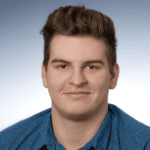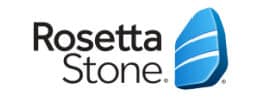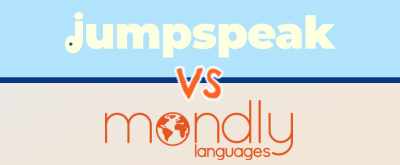Babbel and Rosetta Stone are arguably the two most popular language learning apps in the entire world (apart from maybe Duolingo). And although these two programs do overlap in several respects, they also differ in several ways. In this comparison, we highlight those differences so you can decide which one is the better fit for your learning style.
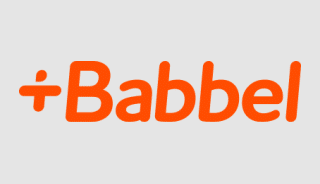
Sale: 55% OFF
Applied in Cart
|
$8-$15/mo |
Our top choice for those just getting into language learning. The perfect introduction app with quick, engaging lessons and foundational content. |
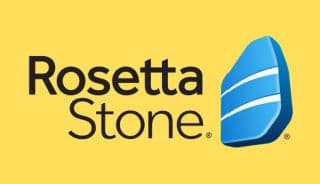
Discount: 60% OFF
Applied In Cart
|
$10-$15/mo |
The classic language learning formula. With a program based on immersion and imagery, this is the perfect app for visual learners. |
Video: Which Language Learning Program Wins?
In the video above, team member Bianca describes the major similarities and differences between the Babbel and Rosetta Stone apps.
Editor’s Choice
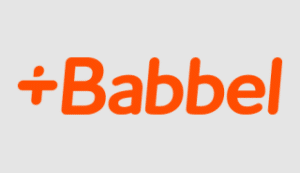
Babbel
- Multiple Subscription Options
- Money Back Guarantee
Pros
- Lessons are more diverse and engaging than Rosetta Stone’s
- Regular review sessions drive home material retention
- Very affordable (as low as $6 per month)
- Streamlined grammar instruction
- Live classes available
Cons
- Wish lessons included cultural insights as well
- No in-depth conversational practice
How The Babbel & Rosetta Stone Programs Differ
To compare these two language learning apps side-by-side, let’s start with a brief overview of each, beginning with Rosetta Stone.
From a top-down look, there are 20 units in the Rosetta Stone program to complete. These units cover major thematic topics, such as Home & Health, Everyday Things, and Work & School. Then within each unit, there are four main lessons.
This means that there are 80 lessons in the entire program, which at first blush, doesn’t sound like a lot. However, each lesson is pretty comprehensive.
Each Rosetta Stone lesson is built around a core 30-minute learning module, with an additional mixture of supplemental drills around that.
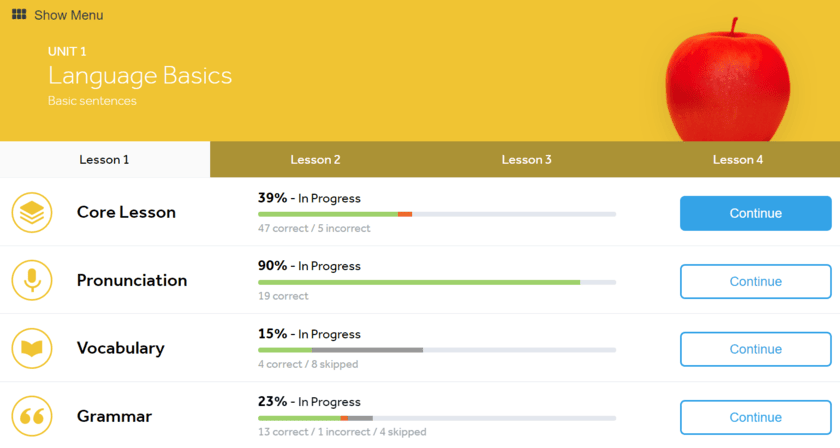
These reinforcement drills cover things such as pronunciation, grammar, reading, vocab, writing, and listening. In terms of duration, those supplemental drills usually each take 5-10 minutes.
As for what each core 30-minute lesson is actually like, the thing to know about Rosetta Stone is that the program is largely built around images. Almost every single exercise consists of a series of pictures, which you use in some way or another.
Sometimes the program will play some audio aloud and you match what was said to the right picture. In some instances it’s matching written phrases to the images. Sometimes it’s verbalizing what you see in the image and having the speech software grade you. And other times the pictures are used to teach grammar.
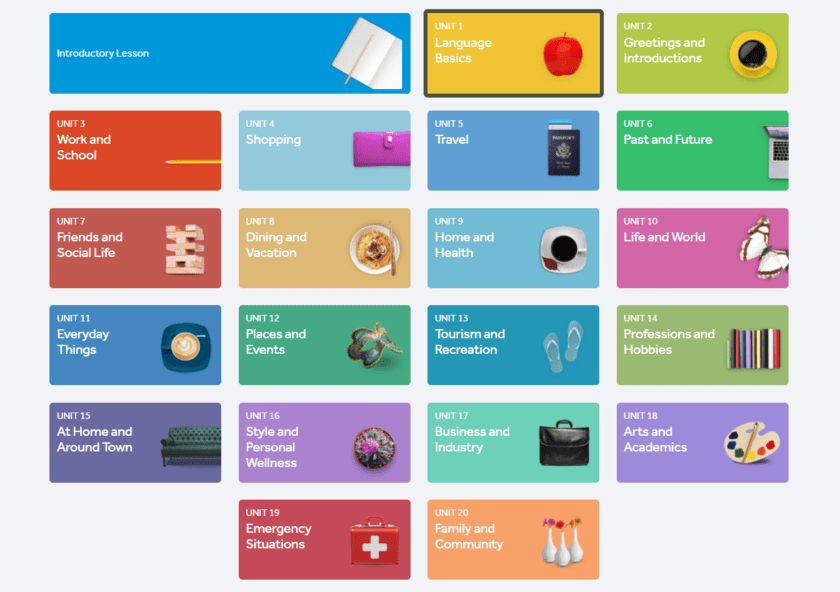
Regardless of how it is carried out, the point is that Rosetta Stone mainly uses pictures to teach the language you’re learning. The program is clearly built to have you create mental associations between what you’re learning and imagery. This forces you to rely more on intuition rather than memorization to learn the language.
The Babbel program is pretty different in its approach. Taking a top-down look at Babbel, there are different learning levels within the program—newcomer, beginner, intermediate, advanced, etc.
Then within each level, there are typically somewhere between two and eight courses that cover different thematic topics, much like how Rosetta Stone does it. Think sports, health, travel, etc.
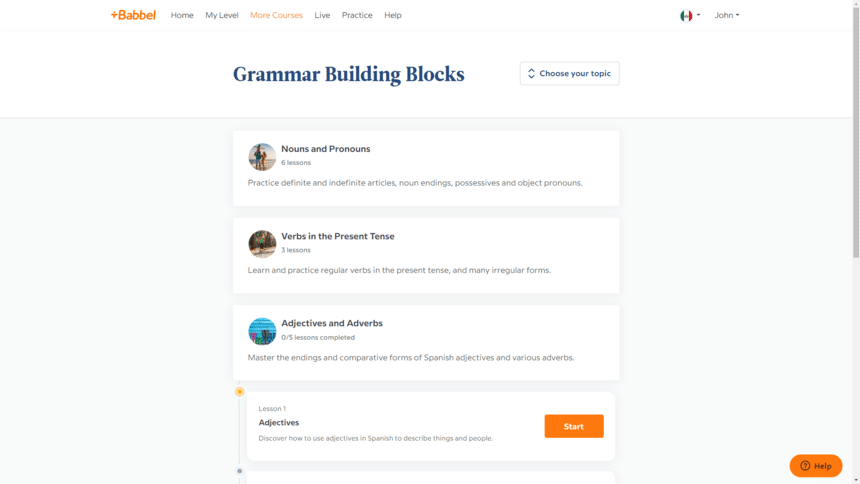
Drilling down further, within each course, there are anywhere from 5 to 15 lessons to complete. This means the Babbel overarching program is organized like a pyramid: Levels 👉 Courses 👉 Lessons
Assuming you have no working knowledge of the language you’re learning, you’ll start with the newcomer level and shoot to complete a lesson per day (or at the very least, a few lessons per week).
As for what the Babbel lessons themselves are like, each one is pretty short in length. On average, they generally take about 15 minutes to complete.
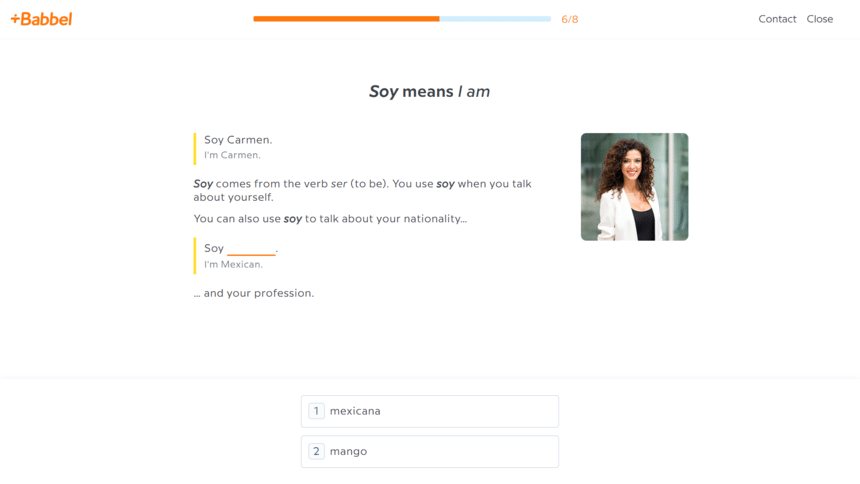
In other words, they go by pretty fast and are shorter than doing an entire Rosetta Stone lesson, which take about an hour to complete when you do the core learning module plus all the little supplemental drills.
The Babbel lessons are shorter because each one is comprised of a series of several quick-hit, hands-on exercises. There are listen-and-repeat exercises, digital flashcards, fill-in-the-blanks, matching pairs, matching phrases to images, completing mock conversations, short instructional tips on grammar, and a few more.
It’s a very diverse approach to learning in terms of format that moves fast. Babbel basically presents the same content in a variety ways and really forces you to interact with the material.

Plus, outside of the lessons, Babbel gives you daily review sessions. This is where you get spaced repetition on vocabulary you’ve already learned in older lessons.
In any event, from a high level, that’s how the two companies compare and contrast.
The big takeaway should be that the Rosetta Stone lessons are very image heavy and each lesson is a little longer, while the Babbel lessons are broken up into more bite-sized chunks and contain more variety in terms of exercises and drills.
Cost Comparison
Before discussing the strengths and weaknesses of each program, let’s quickly touch on cost.
Rosetta Stone has three plans to choose from. First, there is a 3-month subscription plan which costs $12 per month. Then, there’s a 12-month plan which also retails for $12 per month. Lastly, there’s a lifetime plan, which costs $300 and gets you access for life to all of Rosetta Stone’s languages.
As for why the 12-month plan costs the same as the 3-month plan (if you’re wondering), that package is most often found on sale for $8 per month. Similarly, even though the lifetime package retails for $300, you can almost always find a coupon to make it $180 total.
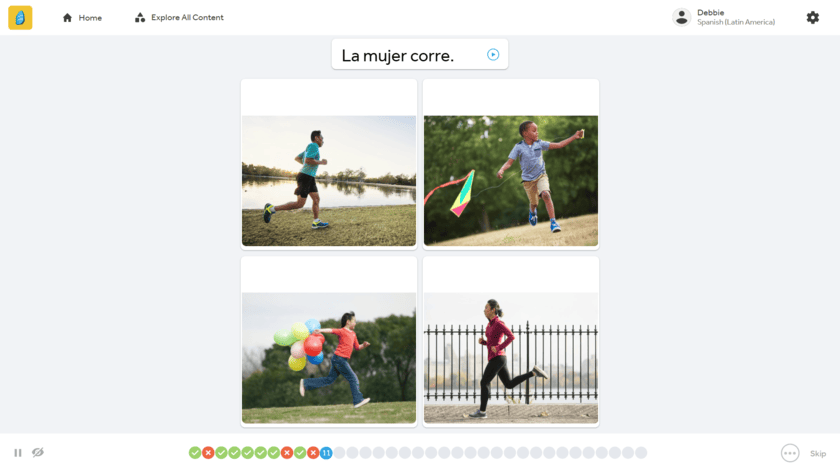
Babbel has a very similar model. They have 3-month plan, 6-month plan and 12-month plan. Those subscription plans all range from around $6 to $14 per month after discounts. Then, similar to Rosetta Stone, Babbel also has a lifetime plan, which includes access to all Babbel languages for $300.
Thus, in terms of cost, these two apps are very close in price, with Babbel’s subscription options perhaps being a dollar or two cheaper per month depending on sales.
Why Babbel Is Better Than Rosetta Stone
Let’s next discuss the strengths and weaknesses of each program, which I think is best addressed by looking at where each program is superior to the other. In particular, let’s focus on the features that make each best for different types of learners. Let’s start with Babbel.
Diversity of Practice Drills
The thing I like most about Babbel’s program over Rosetta Stone is the variety of drills and exercises. One thing you will notice with Rosetta Stone is that the drills can become a little monotonous.
They’re all essentially derivative of one flashcard-style drill. You mostly match pictures to either written phrases or audio.
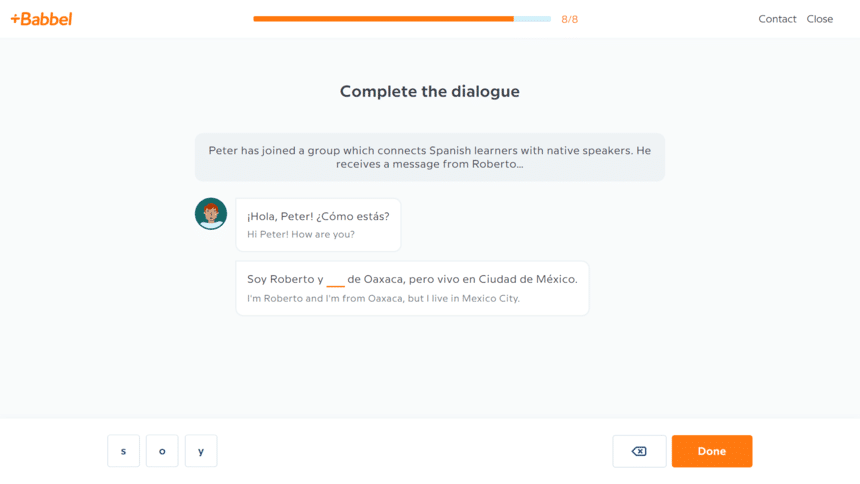
In contrast, the Babbel lessons have a ton of variety in them, which keeps things more balanced and engaging.
As noted above, there are listen-and-repeat exercises, digital flashcards, fill-in-the-blanks, matching pairs, matching phrases to images, mock conversations, short instructional tips on grammar, and some others.
For me, the diversity in the Babbel exercises and drills kept me more engaged during lessons.
Streamlined Grammar Instruction
Another bright spot for Babbel is their grammar instruction. When it comes to grammar, Rosetta Stone does things a little differently than most language apps.
Rather than offering more direct instruction, they allow you as the learner to discover grammar intuitively. In essence, they teach you things like verb conjugations and tenses through the image exercises.
That way, as you see the different sentence structures and verb forms multiple times in the drills, you start to intuitively pick up how the language works.
In contrast, Babbel takes a more direct approach. They work grammar into each and every lesson with straightforward instruction.
There are exercises that teach grammar directly, as well as tips and callout boxes that frequently appear to work in teaching points. Grammar instruction is just more prevalent in the Babbel program and is layered into the course in a very efficient way.
Regular Review Sessions
Another highlight of the Babbel program is their usage of daily review sessions.
Rosetta Stone has a review function too, but you only see it every few days, and only as you get deeper into lessons. In contrast, Babbel leverages reviews much more heavily.
Everyday when you log in to the Babbel app, you’re prompted to do a short review. Essentially, Babbel takes vocab from old lessons you’ve completed previously and pulls them back in for a spaced review.

That way, over the course of the Babbel program, you’ll see every word or phrase at least a half dozen times over the span of multiple months.
Plus, you can choose how you want to review—flashcards, listening, speaking, or writing. Listening is my personal favorite, but I like that they give you the optionality.
Overall, the Babbel review system is really strong for getting you to remember and internalize new words and phrases.
Better Speech Recognition Technology
The last strength that I will note for Babbel (and I might catch some flack for this) is their speech recognition software. In short, I think Babbel’s speech tech is better than Rosetta Stone’s.
Although the Rosetta Stone speech software gets a ton of hype because they have a patent on it, I actually found it to be a little over-sensitive at times. There were some instances where I knew I would be saying a phrase correctly, but it would say I was wrong and make me repeat it. The sensitivity could be a bit frustrating.
To be clear, the Babbel speech tech isn’t perfect—it doesn’t give you detailed feedback like the software from Rocket Languages or Pimsleur, but it was at least less sensitive (in a good way).
The Babbel tech will only make you repeat phrases when you truly butcher a phrase. Therefore, Babbel’s software isn’t over-the-moon amazing, but I did prefer it to Rosetta Stone’s.

Rosetta Stone
- Multiple Subscription Options
- Money Back Guarantee
Pros
- Great option for visual learners (tons of images)
- Immersive learning experience (makes you think critically)
- Very clean and easy to use interface
- Lots of supplemental resources (e.g. phrasebooks and videos)
- More language options than Babbel
Cons
- Lessons are somewhat repetitive (all picture-based)
- Less conversational practice than Babbel
Why Rosetta Stone Is Better Than Babbel
Now that I’ve laid out the areas where I see Babbel being superior to Rosetta Stone, let me break down the strengths of the Rosetta Stone language learning framework.
Great Option For Visual Learners
The first advantage for Rosetta Stone has to be all of the visuals and graphics that permeate their program. If you’re a visual learner, I think there is no doubt that you have to go with Rosetta Stone.
Some people are pure visual learners. They associate the new phrases they learn with imagery so that when they hear that phrase again, the image comes straight to mind.
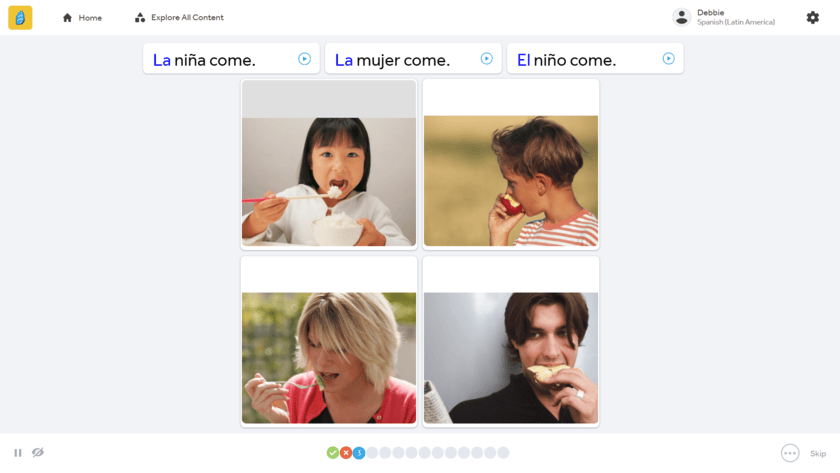
In this way, it sort of cuts English out as a go-between. You’re not learning English equivalents of the language, you’re just learning the language.
Thus, if you’re someone that learns visually and makes mental associations, Rosetta Stone will be a great fit. With all of the pictures in the Rosetta program, it will be very effective for you.
Lessons Force Immersion
Another aspect of Rosetta Stone’s framework that I like is how they leverage immersion. Basically, within the Rosetta Stone program, there is very little use of English. They don’t directly tell you what to do in each exercise in English, or translate words and sentences for you.
This goes back to the point I noted above about learning intuitively. Rosetta Stone wants you to be immersed in the language you’re learning for the period of time that you’re sitting there working exercises, learning by somewhat struggling your way through the material.
To be fair, they do in some parts of the program give you translations, but they are generally turned off by default within the settings.
Plus, the positive spin is that the fastest way of learning a language is being immersed in the culture and hearing the language day in and day out. It’s just the truth of the matter.
Rosetta Stone tries to give you a brief bit of that everyday. To some people, this can be a little frustrating and discouraging because you will get hung up and stuck at times, but if you don’t mind struggling at certain points, it can be highly effective.
Extra Learning Resources
The final advantage of the Rosetta Stone program is the bundle of cool, extra resources that they provide.
Babbel has a decent slate of its own extras, with games and podcasts, but Rosetta Stone offers more supplemental tools than just about every other language learning app.
You get phrasebooks, short on-demand video lessons, stories, audio companion lessons, and even some free live lessons.
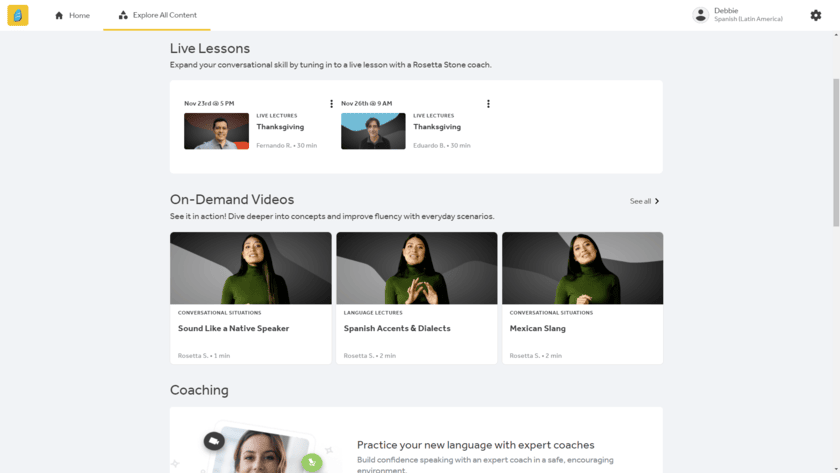
Rosetta just offers an incredibly comprehensive suite of tools for you to use outside of the main lessons, which is a nice bonus (similar to Mango Languages).
Therefore, if you’re very serious about learning your new language and want to do some homework outside of your daily lessons, Rosetta Stone will give you more opportunity to do so than Babbel (and just about every other language learning company).
Verdict: Which Language App Is Better?
While I like both the Rosetta Stone and Babbel programs, for me personally, I prefer Babbel for a few reasons. First, the Babbel lessons are more engaging and balanced because of the variety in their exercises and drills. Second, the daily review sessions are great for spaced repetition and internalizing new phrases. And lastly, I prefer their more direct approach to grammar instruction, rather than relying on intuition like how Rosetta Stone does it.
However, that’s not to say everyone would like Babbel better. If you’re more of a visual learner, or want to be tested daily with a more immersive learning experience, Rosetta Stone could be a better fit and work really well for you.
At the end of the day, however, I personally found the Babbel lessons to more engaging, the right length for me, and ultimately, it was a more effective language learning program.
After using each program, our team believes Babbel offers the more effective language courses and we give them a higher overall rating. Rosetta Stone is a good option for visual leaners because of their image-heavy lessons, but on the whole, Babbel is more balanced, engaging and effective.
Lesson format is one of the biggest differences between Rosetta Stone and Babbel. The Rosetta Stone lessons primarily revolve around matching phrases to images, while the Babbel lessons are more diverse and engaging with a greater variety of practice drills.
Yes, after taking into account discounts and promotions, Babbel usually tends to be more affordable than Rosetta Stone by a couple dollars per month.
